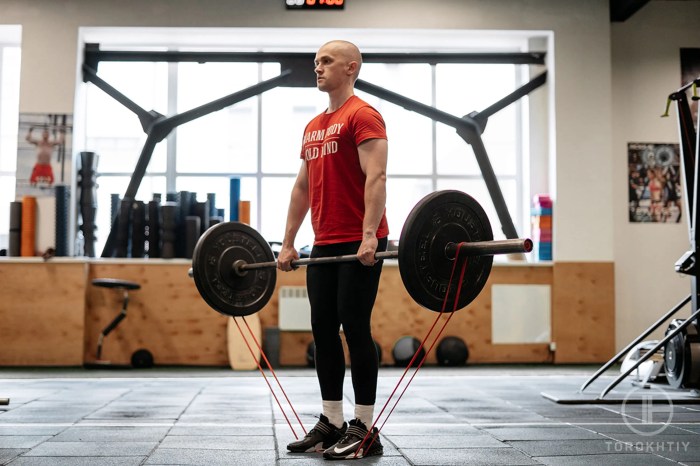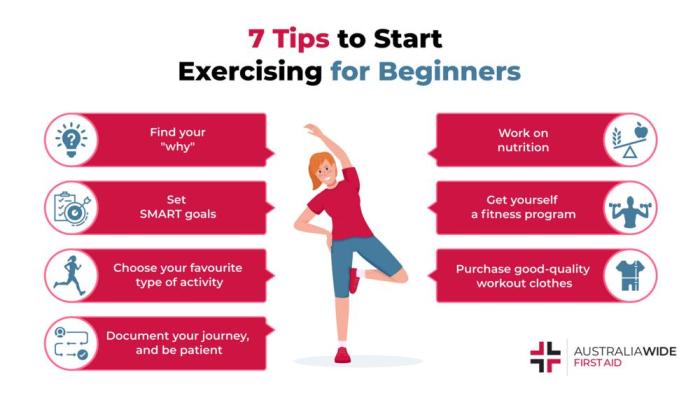7 important but often overlooked tips for working out are crucial for anyone looking to achieve their fitness goals. This guide dives deep into essential elements like proper warm-up and cool-down routines, understanding your body’s limits, hydration and nutrition, rest and recovery, finding a suitable workout routine, maintaining consistency and motivation, and mastering proper form and technique. Each aspect is vital for maximizing your workout effectiveness and minimizing injury risk.
From optimizing your pre-workout routine to crafting a personalized workout schedule that fits your lifestyle, this comprehensive guide offers practical advice and strategies. Learn how to prevent common workout pitfalls and unlock your full fitness potential.
Importance of Proper Warm-up and Cool-down

Proper warm-up and cool-down routines are essential components of any workout regimen, often overlooked but crucial for maximizing performance and minimizing injury risk. They prepare the body for the demands of exercise and allow for a safe transition back to a resting state. A well-structured warm-up gradually increases blood flow, raises body temperature, and primes muscles for exertion.
Similarly, a proper cool-down facilitates the return of blood flow to normal levels, preventing muscle stiffness and soreness.Warm-up and cool-down routines are not merely optional additions; they are fundamental parts of a holistic approach to fitness. They bridge the gap between rest and exertion, optimizing the body’s response to physical activity. By gradually increasing and decreasing exertion, these routines protect against injuries such as muscle strains, tears, and joint pain.
They also contribute to improved performance by enhancing flexibility, range of motion, and overall athleticism.
Benefits of Warming Up
Warming up prepares the body for physical activity by increasing blood flow, raising body temperature, and enhancing flexibility and range of motion. This physiological preparation reduces the risk of injuries such as muscle strains and tears, while also enhancing athletic performance by improving coordination and reaction time. A proper warm-up period also allows the body to adjust gradually to the intensity of the workout.
Warm-up Routines for Different Workout Types
Different workout types necessitate tailored warm-up routines. Cardio workouts, for instance, can begin with 5-10 minutes of light cardio, such as brisk walking or jogging, progressing to a moderate pace. Strength training routines should include dynamic stretches, such as arm circles, leg swings, and torso twists, lasting 5-10 minutes to prepare the muscles for the resistance exercises. Yoga warm-ups often involve gentle movements and stretches to increase flexibility and prepare the body for the poses.
Cool-down Routines for Different Workout Types
Cooling down is as crucial as warming up. It allows the body to gradually return to a resting state, preventing blood pooling and promoting recovery. For cardio workouts, a cool-down can involve 5-10 minutes of light cardio, such as walking, to gradually decrease heart rate and breathing. After strength training, static stretches, holding each stretch for 15-30 seconds, can help improve flexibility and reduce muscle soreness.
Yoga cool-downs typically involve restorative poses that promote relaxation and reduce tension.
Warm-up Activities and Their Benefits
| Warm-up Activity | Muscle Groups Primarily Targeted | Benefits |
|---|---|---|
| Light Cardio (e.g., brisk walking) | Cardiovascular system, lower body | Increases blood flow, raises body temperature, improves cardiovascular function |
| Dynamic Stretching (e.g., arm circles, leg swings) | Specific muscle groups targeted by the movement | Increases range of motion, improves flexibility, prepares muscles for exertion |
| Yoga Poses (e.g., Sun Salutations) | Multiple muscle groups, depending on the pose | Increases flexibility, improves balance, enhances body awareness |
Risks of Skipping Warm-up and Cool-down
Skipping warm-up and cool-down routines can lead to several negative consequences. Muscles are more prone to strains and tears without adequate preparation. The risk of joint injuries also increases significantly. Furthermore, inadequate cool-down can result in delayed muscle soreness and prolonged recovery times. Ultimately, neglecting these crucial phases of exercise can hinder overall fitness progress.
Understanding Your Body’s Limits and Listening to Pain Signals
Knowing your body’s limits is crucial for safe and effective workouts. Pushing yourself too hard can lead to injuries, hindering your progress and potentially causing long-term problems. Learning to recognize the difference between normal muscle soreness and pain that signals an injury is a vital skill for any fitness enthusiast. This involves understanding your body’s response to exercise and respecting its limitations.Recognizing the subtle cues your body gives you is paramount to preventing injuries and maximizing workout effectiveness.
This means paying attention to not only the intensity of the pain, but also its location, duration, and any accompanying symptoms. Understanding the difference between the discomfort of muscle fatigue and the sharp, persistent pain of an injury will help you avoid pushing through conditions that could lead to long-term problems.
Distinguishing Between Muscle Soreness and Pain
Muscle soreness, often experienced after a workout, is a normal response to the stress placed on the muscles. It typically appears hours or even days after exercise and is characterized by a dull ache or tenderness in the affected area. This discomfort is a sign that the muscles are rebuilding and adapting to the workout. However, pain that is sharp, persistent, or accompanied by swelling, inflammation, or other symptoms is a clear signal that something is wrong.
Signs You Should Stop Exercising and Seek Medical Attention
It’s essential to know when to stop exercising and seek medical attention. Ignoring pain signals can lead to serious injuries, and prompt medical intervention can prevent long-term complications.
So, you’re looking for 7 important but often overlooked tips for working out? While physical fitness is crucial, sometimes we overlook the emotional toll of exercise. Learning how to manage emotional sensitivity can significantly impact your workout routine. For example, understanding how to manage your emotions can help you push through those tough workouts and avoid getting discouraged when you don’t see immediate results.
Check out this helpful guide on how overcome emotional sensitivity for valuable strategies to help you navigate those feelings and get the most out of your workouts. Ultimately, these emotional strategies will help you stay motivated and achieve your fitness goals by improving your overall well-being.
- Sudden, sharp pain in a joint or muscle.
- Pain that worsens over time, especially with movement.
- Swelling or inflammation around a joint or muscle.
- Limited range of motion in a joint.
- Popping, clicking, or grinding sounds in a joint.
- Numbness or tingling in an extremity.
- Severe pain that interferes with daily activities.
- Visible deformity or bruising in the affected area.
- Signs of infection, such as redness, warmth, and pus.
These are not exhaustive, but represent significant indicators that require immediate attention.
Ever feel stuck in a workout rut? Seven important but often overlooked tips can get you moving again. But sometimes, the mental block is tougher than the physical one. That’s where powerful questions come in handy. For example, exploring “7 powerful questions get unstuck instantly and moving forward again” 7 powerful questions get unstuck instantly and moving forward again can help you identify limiting beliefs or negative self-talk that’s sabotaging your progress.
Ultimately, these powerful questions, along with the right workout tips, can help you unlock your full fitness potential.
Gradual Progression in Workout Intensity and Duration
Jumping into intense workouts or dramatically increasing workout duration can lead to injuries. A gradual increase in intensity and duration is key to avoiding overuse injuries and allowing your body to adapt safely. Begin with manageable exercises and gradually increase the intensity, duration, or weight over time. Listen to your body and adjust the program as needed.
“A well-structured, progressive training program is essential for long-term fitness and injury prevention.”
This approach allows your body to adapt to the demands of exercise without undue stress. A gradual progression will help you achieve your fitness goals safely and effectively.
Hydration and Nutrition for Optimal Performance
Proper hydration and nutrition are crucial for maximizing workout performance and promoting recovery. Fueling your body with the right nutrients and staying adequately hydrated before, during, and after exercise significantly impacts your energy levels, muscle function, and overall well-being. Ignoring these aspects can lead to fatigue, decreased performance, and even injuries.Understanding the specific roles of different nutrients and the optimal hydration strategies tailored to your workout duration and intensity are key to achieving your fitness goals.
This section delves into the importance of hydration and nutrition for peak performance, providing a comprehensive guide for optimizing your workouts.
Importance of Hydration Before, During, and After Workouts
Hydration is paramount for athletic performance. Dehydration can significantly impair physical and cognitive function. Before a workout, proper hydration is essential to ensure optimal blood flow and nutrient delivery to muscles. During exercise, maintaining hydration is critical to prevent overheating, fatigue, and muscle cramps. Post-workout hydration is vital for replenishing fluids lost during exercise and supporting muscle recovery.
Adequate fluid intake aids in the transport of nutrients, facilitating muscle repair and growth.
Role of Nutrients in Muscle Recovery and Growth
Different nutrients play specific roles in supporting muscle recovery and growth. Carbohydrates provide the primary fuel source for high-intensity workouts, while protein is crucial for repairing and building muscle tissue. Healthy fats provide essential fatty acids, contributing to overall health and supporting hormone production. Electrolytes like sodium, potassium, and magnesium are vital for maintaining fluid balance and muscle function.
Consuming a balanced diet rich in these nutrients is essential for optimal recovery and performance.
Recommended Hydration and Nutrition Strategies
The following table Artikels recommended hydration and nutrition strategies for various workout durations and intensities. These strategies are general guidelines and individual needs may vary.
| Workout Duration/Intensity | Hydration Strategy | Nutrition Strategy |
|---|---|---|
| Light exercise (30-60 minutes) | Drink water or electrolyte beverages before, during, and after the workout. | Consume a snack containing carbohydrates and protein (e.g., a protein bar, Greek yogurt with fruit) before and after the workout. |
| Moderate exercise (60-90 minutes) | Drink water or electrolyte beverages before, during, and after the workout. Consider sports drinks with electrolytes during. | Consume a meal containing carbohydrates and protein (e.g., a chicken salad sandwich with fruit) before and after the workout. |
| High-intensity exercise (over 90 minutes) | Drink water or electrolyte beverages before, during, and after the workout. Consider sports drinks with electrolytes during. Consume fluids at regular intervals. | Consume a meal or larger snack containing carbohydrates and protein (e.g., pasta with lean meat) before and after the workout. Consume protein supplements after the workout to support muscle recovery. |
Detrimental Effects of Inadequate Hydration and Nutrition, 7 important but often overlooked tips for working out
Inadequate hydration and nutrition can have detrimental effects on workout performance. Dehydration can lead to fatigue, reduced endurance, muscle cramps, and heat exhaustion. Insufficient carbohydrate intake can result in low energy levels, hindering workout intensity and duration. Insufficient protein intake can hinder muscle recovery and growth. A lack of essential nutrients can impact overall health and well-being.
Furthermore, deficiencies in electrolytes can disrupt fluid balance and lead to muscle weakness and spasms.
Rest and Recovery Strategies for Muscle Repair
Rest and recovery are often overlooked but absolutely crucial components of a successful workout routine. Just as important as the workout itself, rest allows your muscles to repair and rebuild, leading to greater strength, endurance, and reduced risk of injury. Ignoring this aspect can hinder progress and potentially lead to burnout. This crucial period of downtime is when the body works diligently to adapt to the stresses of exercise, ultimately making you stronger and more resilient.Muscle repair and growth don’t happen during exercise; they happen during the recovery period.
Think of it like this: exercise tears down muscle tissue, and rest allows the body to rebuild it stronger and more efficient. This process is essential for achieving gains in strength and size, preventing injuries, and enhancing overall athletic performance. A well-structured approach to rest and recovery is key to unlocking your full potential.
Importance of Rest Days
Rest days are not a sign of laziness; they are an integral part of a healthy training schedule. Incorporating rest days allows the body to repair damaged tissues, replenish energy stores, and optimize hormonal balance, all of which contribute to long-term fitness goals. Without sufficient rest, the body cannot adequately recover from exercise, leading to fatigue, decreased performance, and increased risk of injury.
A regular schedule of rest days is crucial for consistent progress.
Recovery Techniques
A variety of techniques can support the body’s natural recovery processes. These strategies help alleviate muscle soreness, promote blood flow, and facilitate tissue repair. By integrating these strategies into your routine, you can maximize the benefits of your workouts.
- Active Recovery: Light activities like walking, swimming, or cycling can enhance blood circulation to the muscles, aiding in the removal of metabolic waste products. This gentle movement can improve flexibility, reduce stiffness, and facilitate the recovery process without placing significant stress on the body. For example, a brisk 30-minute walk after a strenuous weightlifting session can promote muscle recovery and reduce delayed-onset muscle soreness (DOMS).
- Foam Rolling: Using a foam roller to massage muscles can improve blood flow and reduce muscle tension. This technique can help release knots and improve flexibility, reducing the risk of injury and enhancing overall recovery. Applying gentle pressure on the affected muscle groups can alleviate pain and tightness, making the recovery process smoother and more efficient.
- Stretching: Regular stretching can improve flexibility, reduce muscle tension, and enhance blood flow. Static stretching, where you hold a stretch for a period of time, can improve muscle recovery and reduce the risk of injury. Dynamic stretching, which involves moving your body through a range of motion, can also be beneficial for warming up before a workout and cooling down afterward.
This can help your body prepare for and recover from exercise more effectively.
Creating a Structured Rest Schedule
A well-structured rest schedule can significantly enhance your workout routine and optimize recovery. It is important to be consistent with rest days to allow for proper muscle repair.
- Identify Your Body’s Signals: Pay close attention to your body’s signals. If you feel overly fatigued or experience persistent soreness, increase your rest time accordingly.
- Listen to Your Body: Don’t push through pain. If you experience pain during or after exercise, it’s important to rest and allow the injury to heal properly. This will help prevent further complications and promote optimal recovery.
- Schedule Rest Days: Designate specific days for rest and recovery. This could be one or more days per week, depending on your training intensity and individual needs. A structured schedule allows your body to fully recover without feeling overwhelmed.
- Incorporate Active Recovery: Incorporate active recovery techniques on your rest days to enhance blood circulation and aid muscle repair. This could include light cardio, yoga, or stretching.
Impact of Sleep on Muscle Recovery
Adequate sleep is essential for optimal muscle recovery. Sleep deprivation can negatively impact muscle protein synthesis, leading to slower recovery and reduced performance.
So, you’re keen on those 7 important but often overlooked tips for working out? It’s a great start! But did you know that building a solid financial foundation is just as crucial as building a strong physique? Learning about 10 investment tips for beginners, like diversifying your portfolio or understanding compound interest, can be surprisingly beneficial. 10 investment tips for beginners can actually help you achieve your fitness goals in the long run.
Ultimately, mastering both your workout routine and your investments are keys to a balanced and fulfilling life, and that’s what this is all about.
High-quality sleep is critical for muscle recovery.
Getting enough sleep allows your body to repair and rebuild muscle tissue effectively, leading to enhanced strength and endurance gains. Aim for 7-9 hours of quality sleep each night to maximize the benefits of your workouts and promote overall well-being. The quality of your sleep, as well as the quantity, impacts the recovery process. Consistent sleep patterns contribute significantly to your body’s natural healing process, impacting muscle repair and overall fitness.
Finding a Workout Routine that Suits Your Lifestyle and Goals
Finding the perfect workout routine isn’t about hitting the gym for hours each day. It’s about creating a sustainable plan that aligns with your individual needs, preferences, and lifestyle. This means considering your fitness level, available time, and personal goals, whether it’s weight loss, muscle gain, or simply improving overall fitness. A well-tailored routine makes exercise enjoyable and effective, ensuring long-term adherence and positive results.Tailoring a workout routine to your specific needs and preferences is crucial for its success.
A rigid, inflexible plan that doesn’t account for your personal circumstances is unlikely to be maintained. Consider your current fitness level, available time, and any physical limitations. Listen to your body and adjust accordingly.
Workout Routines for Different Fitness Levels and Goals
Different workout routines cater to various fitness levels and goals. For beginners, short, low-impact exercises, like brisk walking or yoga, are ideal. As fitness improves, the intensity and duration can be gradually increased. For weight loss, a combination of cardio and strength training is often recommended. For muscle gain, strength training with progressively heavier weights and controlled repetitions is key.
General fitness routines often involve a balance of all three. Remember to consult a healthcare professional or certified trainer before starting any new workout routine.
Workout Routine Adjustments for Lifestyle Changes
Life changes, such as work schedule shifts or family commitments, can disrupt workout routines. Flexibility is essential to maintaining a consistent exercise regimen. If your schedule changes, adjust your workout time or type. Short, high-intensity workouts can be beneficial if time is limited. Prioritize consistency over perfection.
Even short workouts are better than none.
Comparing Workout Types
| Workout Type | Description | Benefits |
|---|---|---|
| Cardio | Activities like running, swimming, cycling, or brisk walking that elevate your heart rate. | Improved cardiovascular health, increased calorie burning, stress reduction, and enhanced mood. |
| Strength Training | Exercises that use resistance to build muscle mass and strength. This includes weightlifting, bodyweight exercises, and resistance bands. | Increased muscle mass, improved bone density, enhanced metabolism, and increased strength. |
| HIIT (High-Intensity Interval Training) | Short bursts of intense exercise followed by brief recovery periods. Examples include burpees, mountain climbers, or jumping jacks. | Increased calorie burn, improved cardiovascular fitness, and enhanced metabolic rate. HIIT can be particularly effective for those with limited time. |
This table highlights the key differences and benefits of various workout types. Choosing the right type of workout or combining different types can create a holistic approach to fitness.
The Role of Consistency and Motivation in Achieving Results: 7 Important But Often Overlooked Tips For Working Out

Consistency is the bedrock of any successful fitness journey. It’s not about achieving perfection every single day, but rather about establishing a sustainable routine that you can stick with over the long haul. Motivation plays a crucial role in maintaining this consistency, fueling your drive and helping you overcome challenges along the way. Without a strong motivational foundation, even the best workout plans can fall by the wayside.Consistency isn’t just about showing up; it’s about creating a habit that integrates seamlessly into your lifestyle.
This integration requires a deep understanding of your personal preferences and limitations. This understanding allows you to design a workout routine that fits seamlessly into your daily life, making it easier to stay committed and avoid feeling overwhelmed or discouraged. By focusing on consistency, you set yourself up for long-term success in achieving your fitness goals.
Strategies for Maintaining Motivation
Motivation is a dynamic force, not a static state. It ebbs and flows, requiring proactive strategies to keep it strong. A key strategy is recognizing that plateaus are normal and expected. Instead of seeing them as failures, use them as opportunities to adjust your approach, celebrate progress, and remind yourself of your long-term goals.
- Setting Realistic Goals: Ambitious goals are great, but they can quickly lead to frustration if they’re unrealistic. Break down large goals into smaller, achievable milestones. This allows for consistent progress, providing regular feedback and reinforcement, and helps you feel a sense of accomplishment along the way. For example, instead of aiming to run a marathon in six months, set weekly running goals, like increasing your mileage or improving your pace.
- Finding a Workout Buddy or Group: Working out with others can significantly boost motivation. Shared accountability and support create a sense of community and encourage you to stay on track. Having a workout buddy or joining a fitness group provides social interaction and can make exercise more enjoyable.
- Rewarding Yourself: Celebrate your progress, no matter how small. This could be anything from buying a new workout outfit to enjoying a healthy meal. Rewards provide positive reinforcement, which strengthens your commitment to your fitness journey. A tangible reward reinforces the effort and encourages continuation.
- Tracking Progress: Monitoring your progress, whether it’s through a fitness app, a journal, or simply noting your improvements, provides a visual representation of your hard work. This tangible evidence of your efforts helps to maintain motivation and provides a sense of accomplishment.
Potential Obstacles to Consistency and Solutions
Consistency isn’t always easy. Life throws curveballs, and motivation can wane. Identifying potential obstacles is crucial for developing strategies to overcome them. Addressing these issues head-on helps maintain momentum.
- Lack of Time: Juggling work, family, and other commitments can make finding time for exercise challenging. Solutions include scheduling workouts like appointments, finding shorter, more effective workouts, or incorporating activity into your daily routine, such as taking the stairs instead of the elevator.
- Boredom with Routine: Repeating the same workout can lead to a lack of motivation. Solutions include varying your workouts, trying new activities, incorporating music or podcasts into your routine, or finding a new fitness class or gym.
- Injuries: Injuries can derail a workout routine. Solutions include seeking professional advice for proper recovery and rehabilitation, adjusting your workout intensity or modifying exercises, and incorporating rest days into your routine.
- Lack of Support: Feeling isolated or lacking encouragement from others can impact motivation. Solutions include seeking support from a fitness buddy, joining a workout group, or engaging with online communities dedicated to fitness.
The Importance of Proper Form and Technique
Proper form and technique are crucial for maximizing workout effectiveness and minimizing the risk of injury. Ignoring proper form can lead to strain on joints, muscles, and ligaments, potentially causing long-term problems and hindering progress. By understanding and practicing correct form, individuals can achieve optimal results and safeguard their well-being.Understanding proper form goes beyond simply mimicking a movement.
It encompasses a deep comprehension of the mechanics involved, the intended muscle engagement, and the alignment of the body throughout the exercise. This knowledge is essential for preventing injuries and optimizing results.
Preventing Injuries Through Correct Form
Proper form significantly reduces the likelihood of injuries during workouts. Incorrect form can place undue stress on joints, ligaments, and muscles, leading to strains, sprains, and other musculoskeletal issues. Understanding the biomechanics of each exercise and maintaining correct alignment during the movement are paramount.
Common Exercise Mistakes and Corrections
Many common exercise mistakes stem from poor form. Addressing these errors is essential for injury prevention and effective training.
- Incorrect Bench Press Form: A common mistake is arching the back during a bench press, which shifts the load away from the chest muscles and onto the spine. To correct this, maintain a neutral spine and engage the core muscles throughout the movement. Ensure your shoulder blades are retracted and your elbows are pointed slightly outward. This promotes a more stable and controlled movement, reducing the risk of shoulder injury and maximizing the engagement of the chest muscles.
- Improper Squat Form: Frequently, individuals squat with their knees collapsing inward during the movement. This can put immense stress on the knees and lead to knee pain. To correct this, maintain a neutral posture and ensure your knees track over your toes. Engage your core and glutes to maintain stability throughout the squat. This approach ensures proper alignment and minimizes the risk of knee injuries.
- Incorrect Deadlift Form: A common mistake is rounding the back during a deadlift. This can cause serious lower back injuries. To correct this, keep your back straight and engage your core muscles throughout the movement. Lift with your legs, keeping the barbell close to your body. Maintaining a straight back and utilizing leg strength helps to distribute the weight evenly, preventing back strain and maximizing the effectiveness of the exercise.
Seeking Guidance from Qualified Professionals
A qualified personal trainer or physical therapist can provide invaluable guidance in correcting form and technique. They can assess individual needs, identify potential weaknesses, and offer tailored advice. Their expertise is particularly important for beginners or those with pre-existing conditions.
Maximizing Workout Effectiveness and Minimizing Injury Risk
By diligently focusing on proper form and technique, individuals can significantly enhance the effectiveness of their workouts while minimizing the risk of injury. This includes mastering the biomechanics of each exercise, paying close attention to body alignment, and ensuring controlled movements. Consistent practice and feedback from professionals further solidify proper form, leading to optimal results.
Epilogue
In conclusion, achieving optimal fitness results hinges on a multifaceted approach that encompasses not just the physical act of working out, but also the mental and logistical elements. By incorporating these seven often-overlooked tips into your routine, you’ll be well on your way to not only building a healthier you but also developing a sustainable and enjoyable fitness journey. Remember, consistency and a personalized approach are key to lasting success.











